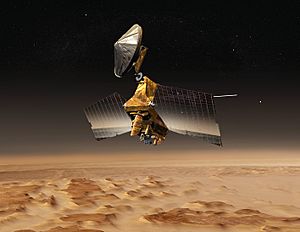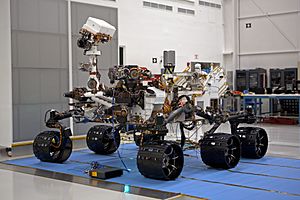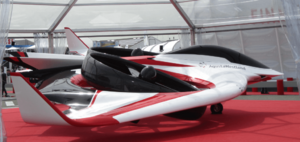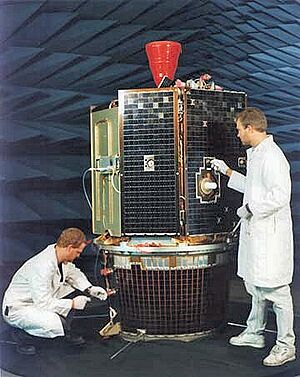VxWorks facts for kids

VxWorks 7 boot-up screen
|
|
| Company / developer | Wind River (a wholly owned subsidiary of Aptiv) |
|---|---|
| OS family | Real-time operating systems |
| Working state | Current |
| Initial release | 1987 |
| Latest stable release | VxWorks 7 25.03 / March 6, 2025 |
| Marketing target | Embedded systems |
| Supported platforms | x86, x86-64, MIPS, PowerPC, SH-4, ARM, RISC-V |
| Kernel type | Monolithic |
VxWorks is a special computer program called a real-time operating system (RTOS). It was created by a company called Wind River Systems, which is part of Aptiv. VxWorks was first released in 1987.
This system is made for embedded systems. These are computers built into other devices. VxWorks helps these devices work perfectly and on time. It is used in many important areas. These include aerospace, medical devices, and robotics.
VxWorks works with many different computer chips. These include AMD/Intel, PowerPC, ARM, and RISC-V. It can run on systems with multiple processors. It works on both 32-bit and 64-bit computers.
The VxWorks system includes its main program (the kernel). It also has other software parts and tools for developers. The newest version, VxWorks 7, is built in a way that makes it easy to update. This helps it work well with the Internet of Things (IoT).
Contents
How VxWorks Started
VxWorks began in the late 1980s. It started as improvements to another simple RTOS called VRTX. Wind River added many new things to VRTX. These included a file system and tools for developers.
In 1987, Wind River decided to create its own core program. This was to replace VRTX within VxWorks. This made VxWorks its own unique system.
A book published in 2003 explains how VxWorks works. It describes the tools and commands used with the system. This book helps people learn about VxWorks.
Important Steps for VxWorks
Here are some key moments in the history of VxWorks:
- 1980s: VxWorks started supporting 32-bit processors. These are common computer chips.
- 1990s: VxWorks 5 was the first RTOS to have a networking stack. This allowed devices to connect to networks.
- 2000s: VxWorks 6 added support for SMP. This means it could use multiple processors at once.
- 2010s: VxWorks began supporting 64-bit processing. In 2016, VxWorks 7 was released for IoT devices.
- 2020s: VxWorks continues to get updates. It now helps power the Mars 2020 lander.
What VxWorks Can Do
VxWorks supports many types of computer chips. These include Intel, PowerPC, and ARM. It can be used in systems with multiple processors. This includes asymmetric multiprocessing (AMP) and symmetric multiprocessing (SMP). It works on both 32-bit and 64-bit processors.
The VxWorks system has two main parts. These are the runtime parts and the development tools. The runtime parts are the operating system itself. They also include software for applications. This software helps with file systems and network connections. The development tools help programmers create software for VxWorks. These tools include compilers and a development suite called Workbench.
VxWorks is designed to be flexible. It works with many different software and hardware parts from other companies. Its main program (kernel) is separate from other parts. This makes it easier to fix problems and add new features.
Extra Features for VxWorks
VxWorks has optional add-ons that give it more abilities:
- Better Security: These features protect devices and data on the Internet of Things (IoT).
- Improved Safety: This allows different applications to run safely together.
- Smart Analytics: This lets devices make quick decisions on their own.
- Java Support: It can run applications made with Java.
- Virtualization: This allows multiple operating systems to run on one device.
Key Features of the System
Here are some of the main things VxWorks can do:
- Multitasking: It can run many tasks at the same time. It handles them quickly and efficiently.
- 64-bit Support: It works with 64-bit computer systems.
- Memory Protection: It keeps different programs separate. This stops one program from affecting another.
- Multi-core Support: It works well with computers that have many processors.
- Error Handling: It has ways to find and report problems.
- Connectivity: It supports many ways for devices to connect. These include Bluetooth and USB.
- File Systems: It can manage different types of file systems.
- Networking: It has a strong networking system for connecting to the internet.
- Debugging: It helps developers find and fix errors in their code.
In March 2014, Wind River released VxWorks 7. This version focused on making the system more scalable and secure. It also improved connectivity and graphics.
Updates in VxWorks 7
Some updates in VxWorks 7 include:
- Modular Design: It is built in parts. This makes it easier to update each part separately.
- Small Size: The main part of VxWorks can be very small, around 20 KB.
- Security: It has features like digital signatures and password management.
- User Interface: It supports advanced graphics for screens and displays.
- New Tools: It comes with updated development tools for programmers.
What Hardware VxWorks Supports
VxWorks works on many different computer platforms. These include Intel x86, MIPS, PowerPC, and ARM chips. Wind River provides a standard way for VxWorks to work with all these different hardware types. This makes it easier for developers to create software. VxWorks also works with security libraries like wolfSSL.
How Developers Use VxWorks
Developers usually use a "host" computer to create software for VxWorks. This host computer has powerful tools. These include editors, compilers, and debuggers. The software is then made to run on the "target" system. The target system is the device that will use VxWorks. This way, developers can use strong tools even if the target device is small.
Supported Computer Architectures
VxWorks supports many computer architectures. These include ARM, Intel, PowerPC, and RISC-V. Developers can find the latest information on supported hardware from Wind River.
The Workbench IDE is a set of tools that comes with VxWorks. It helps developers set up, test, and fix their VxWorks systems. Older versions used a tool called Tornado. Now, Workbench is based on Eclipse. This means it can use many different plug-ins.
Wind River Simics is another tool. It can create a virtual version of the target system. This means developers can test their software without needing the actual hardware. This helps them find problems earlier and faster.
Where VxWorks Is Used


VxWorks is used in many different products. These include aerospace, automotive, industrial, and medical devices. It is also used in consumer electronics and networking. Many famous products use VxWorks as their main operating system.
Space and Aircraft
VxWorks is very important in space missions and aircraft.
- Spacecraft:
- The Mars 2020 rover, which landed on Mars.
- The Mars Reconnaissance Orbiter.
- The Mars Science Laboratory, also known as the Curiosity rover.
- NASA Mars rovers like Sojourner, Spirit, and Opportunity.
- The Clementine (spacecraft) launched in 1994. It used VxWorks 5.1.
- The Phoenix Mars lander.
- The Deep Impact space probe.
- The Mars Pathfinder mission.
- NASA's Juno space probe sent to Jupiter.
- Aircraft:
- AgustaWestland Project Zero aircraft.
- Northrop Grumman X-47B Unmanned Combat Air System.
- Airbus A400M Airlifter.
- BAE Systems Tornado Advanced Radar Display Information System.
- Lockheed Martin RQ-170 Sentinel UAV.
- Boeing 787 airplanes.
- Space Telescopes:
Cars and Vehicles
VxWorks is used in many parts of cars and other vehicles:
- Toshiba image recognition systems for driver assistance.
- Bosch Motor Sports race car systems.
- Hyundai Mobis car entertainment systems.
- BMW iDrive 2.0 systems (from 2003-2008).
- Siemens VDO car navigation systems.
- Most electronic control units in Renault Trucks T, K, and C trucks.
- European Volkswagen RNS 510 navigation systems.
Everyday Electronics
You might find VxWorks in devices you use every day:
- TPLink RE190 Wireless repeater.
- Apple Airport Extreme wireless routers.
- Brother printers.
- Drobo data storage devices.
- Honda robot ASIMO.
- Linksys WRT54G wireless routers (versions 5.0 and later).
- Motorola's DCT2500 digital set-top box.
- ReplayTV home digital video recorders.
Industrial Uses
VxWorks helps many industrial machines work:
- Industrial Robots:
- ABB industrial robots.
- The C5G robotic project by Comau.
- KUKA industrial robots.
- Stäubli industrial robots.
- Yaskawa Electric Corporation's industrial robots.
- Comau Robotics SMART5 industrial robot.
- Test and Measurement:
- Teledyne LeCroy oscilloscopes.
- Some Tektronix oscilloscopes.
- Hexagon Metrology GLOBAL Silver coordinate measuring machine (CMM).
- Transportation:
- FITSCO Automatic Train Protection (ATP) system.
- Bombardier Train Information System.
- Controllers:
- Bachmann M1 Controller System.
- National Instruments CompactRIO controllers.
- Emerson distributed control system controllers.
- AMX controls system devices.
- Rockwell Automation PLCs (Programmable Logic Controllers).
- Schneider Electric Industrial Controller.
- B&R Automation Runtime.
- Storage Systems:
- Imaging:
- Toshiba eBridge photocopiers.
Medical Devices
VxWorks is used in important medical equipment:
- Varian Medical Systems Truebeam for treating cancer.
- Olympus Corporation's surgical generator.
- BD Biosciences HIV/AIDS Monitoring System.
- Sirona Dental Systems: CEREC X-ray CAD/CAM systems.
- General Electric Healthcare: CT and MRI scanners.
- Carl Zeiss Meditec: Humphrey Field Analyzer HFA-II Series.
- Philips MRI scanners and C-arm Radiology Equipment.
Networking and Communication
Many network devices use VxWorks:
- Arkoon Network Security appliances.
- Ubee Interactive's AirWalk EdgePoint.
- A large part of Huawei's telecoms equipment.
- BroadLight’s GPON/PON products.
- Nokia Solutions and Networks FlexiPacket series.
- Acme Packet Net-Net series.
- Alcatel-Lucent IP Touch phones.
- Avaya ERS 8600 and IP400 Office.
- Cisco CSS and ONS platforms.
- Dell PowerConnect switches.
- Ericsson SmartEdge routers.
- Hewlett Packard HP 9000 Superdome Guardian Service Processor.
- HughesNet/Direcway satellite internet modems.
- Mitel Networks' MiVoice Business.
- Motorola Solutions MCD5000 IP Deskset System.
- Motorola SB5100 cable modem.
- Nortel CS1000 PBX.
- Radware OnDemand Switches.
- Samsung DCS and OfficeServ series PBX.
- SonicWALL firewalls.
- Thuraya SO-2510 satellite phone.
- 3com NBX phone systems.
- Zhone Technologies access systems.
- Oracle EAGLE STP system.
Security Concerns
In July 2019, a report showed some security weaknesses in VxWorks. These weaknesses could allow attackers to gain access to devices. They could even bypass firewalls. This could affect many devices that use VxWorks. Many of these devices are very important and hard to update.
See also
 In Spanish: VxWorks para niños
In Spanish: VxWorks para niños




